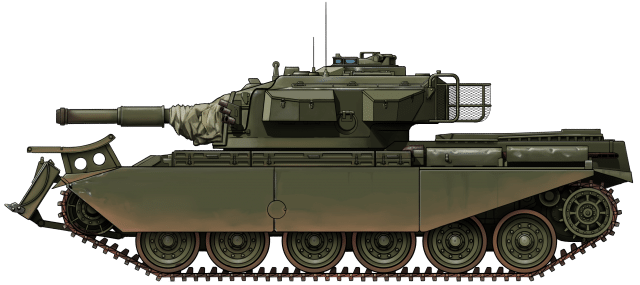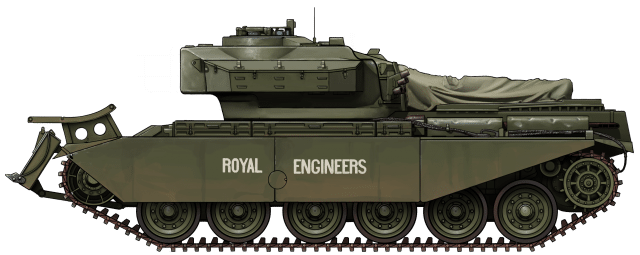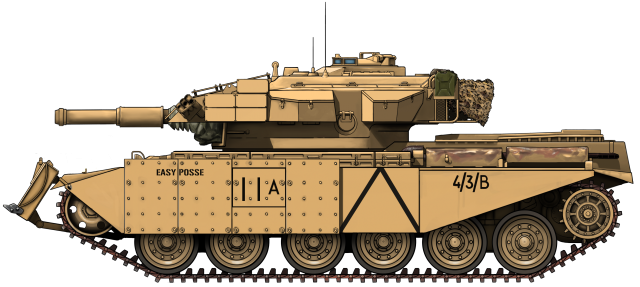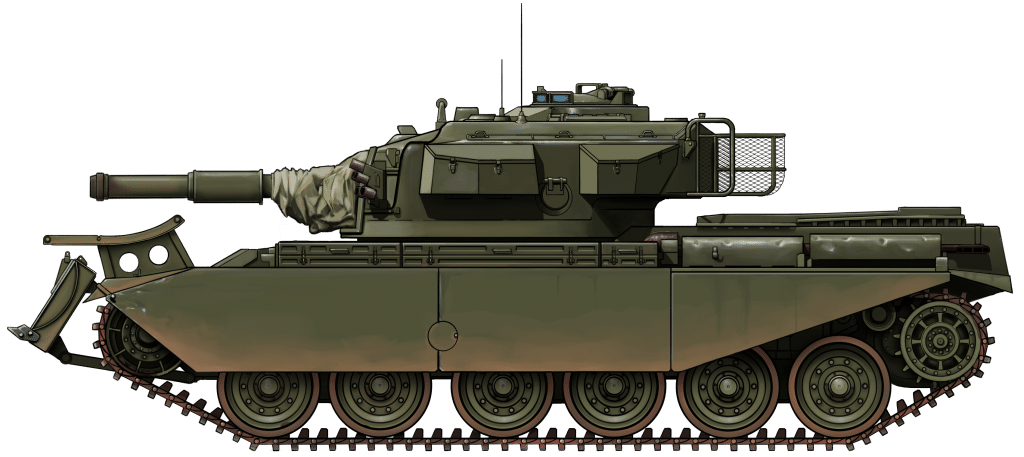 United Kingdom (1955)
United Kingdom (1955)
Engineering Vehicle – Approximately 40 Built
In 1944, a new type of armored vehicle, designed specifically for use by the Royal Engineers (RE), entered service. This was the Churchill AVRE (Armoured Vehicle Royal Engineers). It was based on the Mk.III and IV model of the Infantry Tank, and was famously armed with the devastating 230 mm Petard Mortar.
The Churchill AVRE served honorably throughout the Second World War as part of the 79th Armoured Division, famous for being the home of ‘Hobart’s Funnies’. In 1947, it underwent a limited upgrade program based on the Churchill Mk.VII. This vehicle was designated the FV3903 and was armed with a new 165 mm Demolition Gun. By the mid-1950s, however, the Churchill was obsolete and the Royal Engineers were in need of a new, modern vehicle.
In the late 1940s, the British Army’s new Universal Tank, the FV4007 Centurion, entered service. In 1953, the Engineers’ needs were answered in the form of this new vehicle. At the Fighting Vehicles Research and Development Establishment (FVRDE) in Chertsey, design work began on a new generation of AVRE (The nomenclature now being ‘Assault Vehicle Royal Engineers’), based on the Centurion. Once designs were approved, production began with the AVREs based on the Mk.5 Centurion.

The Mk.5 Centurion
At the time of the Centurion AVRE’s development, the Mk.5 gun tank was a brand new tank, only entering service in the summer of 1955. The biggest difference between this model and its predecessors was a change in coaxial machine guns. The BESA 7.92 mm machine gun had been used on British tanks since the Second World War, but in an effort to standardize ammunition types, it was replaced by the American Browning 7.62 mm (.30 Cal).
In all other major aspects, the Mk.5 was almost identical to the Mk.3. The standard main armament of the Mk.5 consisted of the Ordnance QF 20-Pounder (84mm) gun. It had armor from 51 mm up to 152 mm thick. The vehicle was powered by a Rolls-Royce Meteor engine producing 650 hp and giving the tank a top speed of 22 mph (35 km/h). The tank’s weight of 51 tons was supported on a Horstmann suspension with three two-wheel bogies per-side. The Centurion had a 4 man crew, consisting of commander, gunner, loader and driver. The fact that this variant was based on the Mk.5 tank led it to sometimes being called the ‘Centurion Mk.5 AVRE’.
Development
Obviously, the Centurion AVRE carried much the same equipment as its Churchill predecessor. This included a dozer blade, fascines (large bundles of branches or pipes to fill in a trench) and, of course, a powerful demolition gun. After designs were finalized at the Fighting Vehicles Research and Development Establishment (FVRDE), trials were undertaken in 1954. A standard Centurion was used to test the chassis with the additional weight of a load of fascines and other equipment. The design met the approval of the War Office in July of 1955, and the first prototype Centurion AVRE was delivered to the FVRDE in August 1957.
165mm L9A1 Demolition Gun
Though the 230 mm Petard Mortar of the Churchill AVRE was an extremely powerful demolition weapon, it had had a few flaws. Namely, a limited range of just 100 yards (91 meters) and the fact that the weapon was loaded externally.

The Petard was replaced by the Ordnance BL 165mm (6.5 in) L9A1 Demolition Gun. This weapon was a vast improvement over the Petard in both respects. It was breech loaded and had a vastly improved range. The gun fired a 64 lb (29 kg) High Explosive Squash Head (HESH) shell up to 2,400 m (2,600 yds). The gun was reportedly accurate enough to blast a bridge girder at 600 yards (549 meters) or hit a pillbox or bunker at 1400 yards (1280 meters). At greater ranges, it was an effective Area-Of-Effect (AOE) weapon. The gun could elevate 20 degrees, and depress 10 degrees, though depression was limited over the engine deck.
The shell contained around 32 lbs (14.5 kgs) of PE4 explosives, equivalent to six 120mm HESH rounds. The round had no shell case in the traditional sense. Instead, the charge was placed inside a perforated base connected directly to the warhead and remained attached to the projectile as it flew. The gun and shell were never intended for use as an Anti-Armor weapon. This is not to say that a 165 mm HESH round from the L9 wouldn’t have been able to do so in an emergency, but it was never meant for that purpose.

Equipment
The role of the Centurion was much the same as the original Churchill. As well as its demolition gun, the AVRE carried a vast array of battlefield engineering equipment.
Fascines
Just like the Churchill before it, the Centurion could carry a large fascine over its front end in a cradle mounted on the upper glacis. Fascines had been carried by tanks since their earliest days on the devastated battlefields of the First World War, most notably at the Battle of Cambrai in 1917. Fascines are used to fill wide trenches or ditches to allow tanks to cross. They are usually fabricated from brushwood, bound tightly together into a cylinder. These wooden fascines were 8-10 feet (2.4 – 3 meters) in diameter, and up to 16 feet (4.8 meters) wide. They were heavy at six to seven tons, increasing by an extra ton when wet. They also had the effect of damming when placed in boggy ground or in a stream. This was not ideal as it caused the bundle to shift or even float away. The Royal Engineers soon developed a new type, fabricated from large sections of PVC piping. This new type only weighed around two tons, and fixed the damming issue as water passed straight through the pipes.

The fascine was held in place by cables connected to explosive blow-off pins with the turret traversed to the rear. Carrying the fascine, the vehicle was limited to a speed of 10 mph. Usually, the commander would have to sit atop the turret to guide the driver. This precarious option was rarely used, however, as the driver had suitable vision under the bundle. The technique to deploy the fascine was to drive up to the ditch and brake sharply, simultaneously setting off the blast pins. The inertia of the braking would thereby propel the fascine off the front of the tank and into the ditch.
Dozer Blade
This hydraulically operated dozer blade was shared by the FV4019 Centurion Mk.5 Dozer, and was made by T.B. Pearsons Limited of Newcastle. It was a standard part of the AVRE’s loadout, being permanently fitted to almost every vehicle. However, they were sometimes removed to make way for mine clearing plows. The blade was fitted directly to the upper glacis at the front of the Centurion. In its raised position, the Dozer had the added bonus of acting as extra armor.

The blade had an output capacity of 30 cu yds (23 cu m) per hour and was used for a number of tasks. These included carving out hull-down positions for gun tanks (this could be achieved within 7 minutes), digging gun emplacements, route denial (creating and filling anti-tank ditches), and improving bridge approaches. It could also be used aggressively to push barricades or debris from the path of attacking allies, and even clear inert and unexploded mines. The blade was also used to flatten ground for the application of Class 60 Trackway by ‘back-blading’, dragging the blade back over the ground to grade a uniform surface for the roadway to lie on.

Class 60 Trackway
An extremely versatile piece of kit, this portable metal matting could be used for a number of roles. These included forming a safe bridge approach, helicopter landing pad, stable road over boggy or soft ground, and a safe riverbank exit. The trackway was carried in the same cradle used by the fascine and was deployed in the same manner.
Towed Equipment
Trailer
The AVRE could haul a 7½-ton four-wheel trailer designed to carry a fascine roll, two rolls of Class 60 Trackway, demolition charges, No. 7 Anti-Tank mines, RDD (Radiological Dispersal Device) explosives, and other engineering equipment. The trailer could traverse any terrain the tank could, without hindering it. It could be jettisoned when required via an exploding pin in the jointed towing hook.

Barmine Mechanical Minelayer
Two of these devices could be towed by the AVRE. These were attached to the back of the trailer for mine laying operations. The trailer could carry and deploy 864 mines, compared to the 114 of the FV432 APC when it was fitted with the minelayer.
Giant Viper
Another trailer borne-device which was towed by the AVRE. A development of the World War Two ‘Conger’, the ‘Giant Viper’ was a mine clearing device used to clear large areas of explosive devices such as IED’s or landmines or clear a path through barbed wire. The Viper was mounted on a trailer that was towed by the tank. It consisted of a 750ft (229 m) long, 2 ⅝ inches (6.6 cm) diameter hose filled with plastic explosives. The Viper would be launched over the tank via a cluster of eight rocket motors, then landing in the area that had to be cleared and exploding. The blast would clear a pathway 24ft (7.3m) wide and 600 ft (183 m) long. The device was carried on the back of a unique two-wheel trailer.

Designations
There would be two variants of the Centurion AVRE. These were the standard 165 mm Demolition gun armed version, known as the Centurion 165 AVRE, and the 105 mm L7 armed Centurion 105 AVRE. Both vehicles shared common AVRE equipment.
The 105 AVREs appeared in the early 1980s and were based on Mk.12 Centurions, apart from a solitary Mk.13 used for tests. There were two versions, the standard AVRE Mk.12, and the AVRE Mk.12 H (H for Hydraulic). These versions were equipped with hydraulic systems that allowed them to use the Dozer Blade or Mine Plough. The standard Mk.12 AVREs could only carry the Mine Plough. They retained the standard 105 mm L7 tank gun, but they were limited to just firing HESH rounds. This gave the 105 AVREs the ability to carry out the same demolition jobs like the 165 AVREs at a greater range, but with slightly less explosive power.
The 105 AVRE could still carry a fascine with the turret traversed. The standard Mk.12s became specialized mine-clearing variants of the AVRE. Instead of the standard dozer blade, the tanks were fitted with track-width mine ploughs. The AVRE would use this in conjunction with the Giant Viper. The AVRE, with mine plow lowered, would drive the path cleared by the Viper’s detonation. The turret would be traversed so the gun was off to one side or positioned over the engine deck to protect it from any detonations. The plough would push any unexploded or pressure-insensitive mines to the side of the path, out of the way of following allied armor.

Service
Trials with the Centurion AVRE began in February 1962. It finally entered service with the Royal Engineers in 1963 alongside the FV3903 Churchill AVRE, as it gradually took its place. It was assigned to the three Armoured Engineer Squadrons of the 32nd Assault Engineer Regiment. These consisted of the 26th, 31st, and 77th Armoured Engineer Squadrons. Originally, each squadron’s arsenal consisted of three AVREs (105s and 165s), two Centurion Bridge Layers and a troop of four FV4016 Centurion ARKs (Armoured Ramp Carriers). This would later become more flexible to suit the tactical situation at hand. The AVRE’s roots in the 79th Armoured Division and ‘Hobart’s Funnies’ were never forgotten. To this end, most of, if not all of the Centurions had the famous Bulls Head insignia of the 79th applied somewhere on their armor.
Only the British Army would ever use the Centurion AVRE. It took part in annual training exercises in the UK, Germany, and even BATUS (British Army Training Unit Suffield) in Canada. It famously saw action in ‘The Troubles’ in Northern Ireland in the early 1970s, and later in the First Gulf War in the 1990s. It is these situations that will be focussed on in this article.

Operation Motorman
In response to the ‘Bloody Friday’ bombings of Belfast, the British Army initiated Operation Motorman. The aim of the operation was to take back the ‘no-go’ areas in Irish Nationalist (A group that wanted Ireland to be a unified country, free from the rule of the UK) communities and dismantle the barricades that surrounded them. Barricades had sprung up in many Northern Irish Communities in response to sectarian attacks. The Irish Nationalists built barricades in their communities to defend from attacks by Loyalists (A group that wanted Northern Ireland to remain British) and to deny access by the Police force in Northern Ireland, the Royal Ulster Constabulary (RUC). Although some Loyalist communities also erected barricades, the most famous ‘no-go’ area was in the Bogside neighborhood of Londonderry, known simply at the time as ‘Derry’ to the Nationalist community.
Preparation for the commencement of Operation Motorman started with the drafting in of an extra 4,000 troops. This brought the estimated total of troops in the area to 21,000, including 27 infantry and two armoured battalions. With the cover of darkness, HMS Fearless, an amphibious assault ship, unloaded a number of Centurion AVREs with Dozer Blades ready.

At 4 am on the morning of 31st July 1972, the Army moved into all ‘no-go’ areas. The AVREs would not fire a shot during the operation. Instead, they advanced with turrets fully traversed and used their heavy dozer blades to smash through the barricades. They then swept a path through the debris, pushing brickwork, bollards, concrete metal scrap, and even cars from the roads of the neighborhoods, clearing the way for the Army’s smaller wheeled armored vehicles.
The operation was intended to be a bloodless one as, knowing they were outgunned and outnumbered, the IRA (Irish Republican Army) had mostly fled the areas putting up little resistance. Unfortunately, two local teenagers were shot and killed which, regardless of the circumstances, simply further inflamed the community. However, the operation did substantially quell the levels of violence in the province.

Gulf War
The AVRE remained in service long after its gun tank cousins had been retired by the British Army. The Centurion AVRE was still a key part of the Royal Engineer’s arsenal in the early 1990s. By this time, however, it was a struggle to keep them going due to lack of spare parts, and the age of the vehicles. Some were almost 40 years old at this point. Units operating them became known as the ‘Antiques Roadshow’. Even so, 12 Centurion AVRE’s were sent to the Gulf for Operation Granby, the codename given to British operations in the 1990-1991 Gulf War. It is known that one of the Centurions that went to the Gulf had also been part of Operation Motorman some 19 years prior.
With the expectation that the Armoured Engineers would lead the charge against the Iraqi Army’s formidable field fortifications and anti-tank defenses, the AVRE were drastically up-armored. This was one of the first tasks undertaken by the Engineers. Explosive-Reactive Armor (ERA) was applied all over the front half of the vehicle in an attempt to defend it against most of the enemy’s anti-tank weapons. In the event, the breaching would actually be achieved by the United States 1st Infantry Division.

The second task undertaken by the Engineers was training to operate the 165 mm gun. Because of safety regulations, the 165 mm on the AVREs had not been fired under-armor (from inside) since the late 1960s. Instead, the crew would load the gun while the tank was in a static position, and then fire via lanyard from outside. Due to an end of production of the 165 mm ammunition in the UK, stocks were low. To solve this, a number of AVREs were issued American 165 mm ammunition, usually issued to the M728 CEV (Combat Engineer Vehicle). The American ammunition was two inches longer than the British ammo, so storage became limited inside the tank.
The AVREs didn’t have the best of times in the Gulf. Three were lost in two separate training incidents, both involving vehicle fires and subsequent detonation of ammunition stored inside the tank. A single AVRE was destroyed in the first incident on 5th February 1991 and two were destroyed in the second incident on 6th February 1991. The incident on the 5th seems to have been caused by petrol fumes that ignited whilst cooking took place in the vehicle. The incident on the 6th was due to accidental ignition of the Giant Viper launch rockets while testing the firing circuits. There was a gigantic explosion, with debris flying hundreds of meters away. Fortunately, the crew only sustained minor injuries.

In the event, the AVREs would never take part in a combat operation. After the cease-fire, however, they did take part in an important mission. The Multa Pass, North of Kuwait, was the Main Supply Route (MSR) to the Northern Border with Iraq and it was heavily blocked with wrecks of tanks, trucks, artillery pieces, civilian vehicles, rubble, and all kinds of unexploded ordnance thanks to numerous attacks by marauding US A-10 Warthog ground-attack aircraft. All other routes were compromised as there were minefields everywhere on the side of the Basra Road connecting Kuwait City to Iraq. Centurions were dispatched to the area as well as Chieftain AVREs. The Chieftains were used to haul vehicles that were still able to roll out of the area, while the AVREs were used to shunt armored vehicles around with crew under armor just in case they ‘cooked-off’ (ammunition blew). The US Graves service was supposed to have cleared the area of the dead, but numerous corpses littered the site. For example, when one of the Centurions tipped over a mangled bus, 30 bodies of people attempting to hide from the A-10 strikes were exposed.
The old engineering workhorses completed the grisly task, and the crews were commended for their work. It was the last military operation undertaken by the Centurion AVREs.

Fate
Upon their return from the Gulf, the AVREs were gradually phased out. By 1992, both 165 and 105 AVREs had been retired. The AVREs had extended the service life of the Centurion to 45 years. Only the Centurion BARV (Beach Armoured Recovery Vehicle) exceeded this lifetime, remaining in service until 2003.
The Centurion AVRE would be replaced in service by the Chieftain AVRE, also known as the ‘CHAVRE’, which started life in 1989. The CHAVRE was however, unarmed, making the Centurion the last armed AVRE to serve in the British Army. It continued to carry fascines, trackway and also retained the ability to clear mines and tow heavy loads. The CHAVRE also served in the Gulf alongside the Centurion.
Fortunately, a number of AVREs do survive in a number of museums across the UK. One can be found in the desert colors of the 1990-1991 Gulf War at the Imperial War Museum in Duxford, Cambridgeshire. The Norfolk Tank Museum has an almost pristine running example that they run at the ‘Armourfest’ festival. It has the ID number 02 BA 58 and is known to be a veteran of the Gulf War. Another AVRE can be found at the Wight Military and Heritage Museum on the Isle of Wight. Its ID number is 12 BA 55. It is a Gulf War veteran and remains in Desert colors. One more AVRE can be found at the Cobbaton Combat Collection, North Devon. Their vehicle, named ‘Bombastic’ had survived action in the Gulf War, but while it was being craned onto a transport ship to head back the UK, a lifting lug broke and it plunged into the ocean. It was recovered, and some years later ended up in the Collection. Despite its salty bath, and its age, the vehicle is still running.



The standard Centurion AVRE entered service with the Royal Engineers (RE) in 1963. It was armed with the 165mm L9A1 Demolition Gun and equipped with a bulldozer blade. Also, note the fascine cradle on the bow.

A Centurion AVRE of the Royal Engineers as seen during Operation Motorman, Creggan Estate, Londonderry, Northern Ireland 1972. The L9 guns never fired a shot and only the tank’s dozer blades were used.

A Centurion 105 AVRE with mine-plow and Giant-Viper trailer. The 105 AVREs started to appear in the early-1980s. These variants of the AVREs were based on Mk.12 Centurions and retained their 105mm L7 guns.

Centurion AVRE ‘Easy Posse’, Operation Granby, 1990-1991. The last operational use of the Centurion AVRE came during the 1990-1991 Gulf War. The tanks were so old that units operating them became known as the ‘Antiques Roadshow’. While here, the tanks were up-armored with panels of Explosive-Reactive Armor (ERA) over the front of their hulls and turrets.
These four illustrations were produced by Ardhya Anargha, funded by our Patreon campaign.
Specifications |
|
| Dimensions (L-W-H) | 7.82 m without gun x 3.39 m x 3 m (25’7″ x 11’1″ x 9’87” ft.in) |
| Total weight, battle ready | 57.1 tons (114,200 lbs) |
| Crew | 4 (commander, driver, gunner, loader). |
| Propulsion | Rolls-Royce Meteor; 5-speed Merrit-Brown Z51R Mk.F gearbox 650 hp (480 kW), later BL 60, 695 bhp |
| Speed | 48/30 km/h road/cross-country (29.82/18.64 mph) |
| Range/consumption | 190 km (118 mi) |
| Armament | 165 AVRE: 165mm L9 Demolition Gun, 105 AVRE: 105mm L7 gun. One coaxial 7.62 mm L8A1 (0.3 in) machine-gun |
| Armor | Turret front 7.6 in, glacis 4.72 in, sides 1.37 in (195/120/35 mm) |
| Ammunition used | High explosive squash head (HESH), Armor-piercing discarding sabot (APDS) |
| Total production | Aprx. 40 |
Resources & Links
Account of ‘Operation Motorman’ (PDF)
www.militaryimages.net
norfolktankmuseum.co.uk
www.arrse.co.uk
Shortest Gap, Story of the Armoured Engineer Vehicles of the Royal Engineers, Micheal Osbourne
Pen & Sword Books Ltd., Images of War Special: The Centurion Tank, Pat Ware
Haynes Owners Workshop Manual, Centurion Main Battle Tank, 1946 to Present.
Osprey Publishing, New Vanguard #68: Centurion Universal Tank 1943-2003
Dorling Kindersley/The Tank Museum, The Tank Book: The Definitive Visual History of Armoured Vehicles
The Tank Museum, Bovington
The Cobbaton Combat Collection, North Devon
Imperial War Museum (IWM)


6 replies on “FV4003 Centurion AVRE”
There is also a Centurion AVRE (as well as a BLV and ARK) at the Royal Engineers Museum in Chatham (UK).
” . . . The old engineering workhorses completed the *grizzly* task, and the crews were commended for their work . . . ”
You mean ‘grisly’.
Fixed.
– Author
On the left of the driver station there is another hatch. Was it for a 5th crew member?
yes there was a 5th crew member position next to the driver
nominally called the spare driver but in reality it was normally a new crew member learning the ropes if there was enough troop member to fill this place
There is another surviving Gulf war vet for sale on Tanks-alot
https://tanks-alot.co.uk/product/centurion-avre-fosgene/